Croydon Corporation Tramways
History
Croydon Corporation became a tramway owner on the 6th June 1897, when it completed a short connecting line in High Street between two Croydon Tramway Company-owned lines (the route northwards to Thornton Heath Pond and the route southwards to South Croydon), which it then leased to the company. The lease was, however, only destined to last for just over two years, a public meeting in October 1897 overwhelmingly expressing a desire that the tramways be taken into municipal ownership. On the 16th October 1899, the corporation formally decided to purchase the horse tramway, presumably under powers enshrined in the Tramways Act of 1870, and to lease its operation to the British Electric Traction Company, a concern which over the course of its history either owned, part-owned or leased over 50 tramway concerns across the British Isles.
The horse tramway was acquired on the 22nd January 1900, its operation presumably being handed over to the BETCo given that the corporation did not have approval to operate a tramway. Conversion of the standard-gauge tramway to overhead electric traction was to be undertaken by the British Thomson-Houston Company, with operation leased to the BETCo for 21 years, each party, i.e., the corporation and the company, having the right to terminate the agreement after 5 years. Meanwhile, the corporation applied for powers to convert and extend the system, the resulting bill — the Croydon Tramways and Improvements Act 1900 — receiving Royal Assent on the 6th August 1900.
Work commenced in late 1900, the existing horse tramway lines being reconstructed, with the extensions being inspected by the Board of Trade, which to the corporation's surprise only authorised their use for horse traction. Quite why this was a surprise is unclear, as to obtain approval for electric tramway operation, the Board of Trade inspector needed to see a working electric tramway, which the corporation did not yet have.
Electric services were introduced on a line-by-line basis, commencing on the 26th September 1901 on the main north-south line (between Norbury Station and Purley Fountain, via London Road, North End, South End and Brighton Road). Further electric services were introduced on the 4th January 1902 (eastwards from Crown Hill to Addiscombe, along George Street); on the 10th January (northeastwards from the main line at Thornton Heath Pond along Brigstock Road to Thornton Heath Station); on the 24th January 1902 (northeastwards from the main line along Station Road to Selhurst Station); on the 14th March 1902 (northeastwards from Selhurst Station, along Selhurst Road to South Norwood); and on the 17th November 1902 (northwards from Norbury Station to the municipality's northern boundary at Hermitage Bridge). The latter was the last line to be opened under the original legislation.
The horse-drawn services were probably withdrawn in late January or early February 1902, the precise date seemingly not having been recorded.
The corporation applied for powers to build further extensions during 1905, which were granted on the 13th February 1906; however, only one of these was built, a line joining the South Norwood and Thornton Heath lines along White Horse Road, which had formerly been traversed by the horse tramway. History duly repeated itself, the loss-making line only lasting until the 8th March 1913, when it was closed, as it had been in horse-tramway days.
The relationship between the corporation and the BETCo appears never to have been a particularly happy one, and when it became clear that the BETCo was taking concrete steps to create its own network surrounding Croydon (to the northeast, northwest and southwest), which would connect to the corporation lines, the corporation took umbrage. A particular bone of contention was the company's intention to construct lines within the corporation's boundary, which the latter would not then own, a situation that was clearly anathema to it. Relations between the two deteriorated rapidly, which resulted in the corporation deciding — on the 29th May 1905 —not to renew the company's lease. Meanwhile, the company had obtained powers to construct a tramway from Penge, along Croydon Road to the Croydon Corporation boundary at Selby Road, and seeing which way the wind was blowing, had succeeding in including a clause which enabled them to build a line from the boundary to meet the corporation terminus at South Norwood, should the corporation choose not to build it. The corporation, its hands effectively tied, grudgingly built the connecting line, but totally ignored the legislation, which stipulated double track, instead laying single track with loops. This seems to have been a fairly thinly disguised move to handicap any through services, though the corporation was lucky that the Board of Trade seemed disposed to ignore the rather blatant contravention. The company retaliated by refusing to lend the corporation a tramcar for the Board of Trade inspection, the corporation eventually loaning one from East Ham Tramways, which had to be brought on a trailer hauled by a traction engine.
The extension to Penge was approved on the 13th February 1906, taking the corporation system to 11.92 miles, tramcar services initially running right the way through from Croydon to Penge (operated by the company). The convenience to passengers was, however, short lived, the corporation immediately cutting back services to the municipal boundary when it took over operation on the 1st June 1906, passengers then having to change to a company tramcar.
Normal relations were eventually restored, with agreement for the corporation to run through to Penge (over BETCo tracks, which were by then owned by its subsidiary, the South Metropolitan Electric Tramways Company) and for the SMET to run through from Crystal Palace to West Croydon (over corporation tracks). Through running commenced on the 24th June 1907. The corporation's benevolence, however, never extended to allowing the SMET to run through services between its lines to the east of the town and those to the west (i.e., Mitcham and Sutton). Although a connecting line was eventually built between the Croydon terminus of the SMET's western lines (in Tamworth Road), this was only ever used for tramcar movements to and from depots.
An opportunity for through running to the north presented itself at the CCT's northern terminus at Hermitage Bridge in Norbury, when London County Council Tramways extended its Streatham line to within 6ins of the corporation's. There were, however, significant technical hurdles to through running with the LCCT, due to the latter's use of conduit current collection, which would require the CCT to equip a significant number of its cars for dual operation (conduit and overhead). Although the LCC commenced services to Norbury on the 31st July 1908, it was to be another 17 years before the gap was closed.
Like many tramway systems across the British Isles, the CCT emerged from the Great War with a huge backlog of maintenance and much of its infrastructure life-expired. Matters were not helped by the corporation's predilection for using the tramway's operating surplus to subsidise the rates, though in the end the corporation bit the bullet, and invested heavily in track renewal and tramcar rebuilding. Unfortunately, the tramway was by this time subject to motorbus competition, primarily from Thomas Tilling Limited, but also from other independent operators; although competition was eventually restricted by the London Traffic Act of 1924, by the early 1920s the tramway was losing money heavily, such that there were calls for its abandonment.
The corporation nevertheless pressed on with the tramway, and was finally able to gain the agreement of the LCCT to through running along the north-south main line (in 1924), which commenced on the 7th February 1926. However, this came at significant cost, the corporation having to purchase 25 dual-equipped (conduit and overhead current collection) tramcars. The Addiscombe line eventually became a casualty of the post-war outlay, closing on the 28th March 1927 in favour of London General Omnibus Company motorbuses, the corporation baulking at further expenditure to replace the time-expired track.
The corporation must have felt more than a little indignant when, after all this expenditure, control of its system — along with 13 other London tramway systems — passed to the newly created London Passenger Transport Board on the 1st July 1933, though it can't have been too sorry to see the LPTB take over nearly £200,000 of debt that it had incurred in renewing the tramway.
The last tram of all in Croydon, operated by the LPTB, ran on the 7th April 1951.
Uniforms
Photographic evidence suggests that staff working the horsecar services — from the takeover of the Croydon Tramways Company in January 1900 through to their withdrawal in early 1902 — who presumably worked for the BETCo, continued to wear the same type of informal attire they had worn in company days. Other than Public Carriage Office badges (see link), no insignia of any kind appears to have been worn. This is consistent with the BETCo's approach to other horse-tramway systems that it ran and electrified, which was, broadly speaking, to only issue uniforms to staff working the new electrified services.
Photographs taken during the BETCo's tenure (1901 to 1906) show that staff working the new electric services were issued with the familiar and largely regulation BETCo uniform. Although jackets appeared to have varied somewhat between BETCo systems, as well as across the decades, the cap badges, collar designations and buttons invariably followed a standard pattern. The jackets, which were of blue serge, were double-breasted with four pairs of buttons (of the standard BETCo pattern — see link), three pockets at waist level, and lapels; the collars carried individual embroidered system initials — 'C. C. T' — on both sides. The tensioned-crown peaked caps bore the standard BETCo ‘Magnet & Wheel’ cap badge, below which an employee number was worn. The badges and buttons were almost certainly brass. Although this style of double-breasted jacket — with its decidedly naval appearance — was relatively quickly superseded on the vast majority of BETCo systems where it was used, this had not happened in Croydon by the time the corporation took over operation of the system in 1906.
Curiously, the BETCo did not see fit to use employee numbers on its other two London systems (Metropolitan Electric Tramways and South Metropolitan Electric Tramways), so it may be that this was a requirement of the owners, Croydon Corporation.
Following the corporation take-over, staff continued to wear very similar, if not identical double-breasted jackets (of deep navy-blue serge with red piping), but with brass Croydon Corporation Tramways buttons (see link). At some point, the button arrangement on the jackets was changed from four pairs (with the top set mounted between the lapels and collars) to five pairs (with the top set mounted between the lapels and collars). Caps also followed previous practice, with an employee number (in brass numerals), but with the BETCo 'Magnet & Wheel' badge replaced by an elaborate cap badge comprising a municipal device and motto, surrounded by a wreath, all above the full system title: 'CROYDON CORPORATION TRAMWAYS'. In later years, the crowns (tops) of the caps had a plaited-straw finish.
Tramcar staff in both the BETCo and municipal eras always appeared in service wearing enamel Public Carriage Office badges issued by the Metropolitan Police (see link), usually worn on the left breast. They were also provided with heavy double-breasted greatcoats with five pairs of buttons and lapels; the collars carried embroidered 'C. C. T' system initials.
Croydon Corporation also employed the services of points boys; these young men appear to have worn the same uniform as tramcar crews, but without an employee number.
In the early years, inspectors wore uniforms that followed standard BETCo practice, namely, single-breasted jackets with hidden buttons (or more likely a hook and eye affair) and stand-up collars; the latter carried the designation 'Inspector' in embroidered script lettering. The tensioned-crown, peaked caps bore a standard BETCo 'Magnet & Wheel' cap badge, along with a hat band bearing the grade 'Inspector' in embroidered script lettering.
Similar uniforms appear to have been worn during the municipal period, but with a metal script-lettering 'Inspector' grade badge, worn below the standard the municipal cap badge, and with block-capital grade badges on the collars.
The corporation also employed regulators; they wore the same style of uniform as inspectors, but with 'Regulator' grade badges.
Examples of a small, round, blue enamel badge, bearing the full system title — 'CROYDON CORPORATION TRAMWAYS' — have also survived; it is unclear what these were used for, though they may have been worn on inspector's caps or greatcoats in later years, i.e., the 1920s.
Female staff were employed in significant numbers during the Great War as conductresses (from late 1915 to 1919), to replace male staff lost to the armed services. They were provided with tailored single-breasted jackets bearing five buttons, high fold-over collars and a waist belt (with button fastening), along with medium-length matching skirts and lace-up gaiters; the jacket collars bore 'C.C.T' in prominent embroidered letters. Two types of headwear are known, dark-coloured straw bonnets and waterproof bonnets, both with brims; these hats usually bore a metal employee number (in individual metal numerals) and the standard cap badge.
Further reading
For a history of Croydon Corporation Tramways, see: 'Croydon Tramways' by Robert J Harley; Capital Transport Publishing (2004).
Images
Horse tram drivers and conductors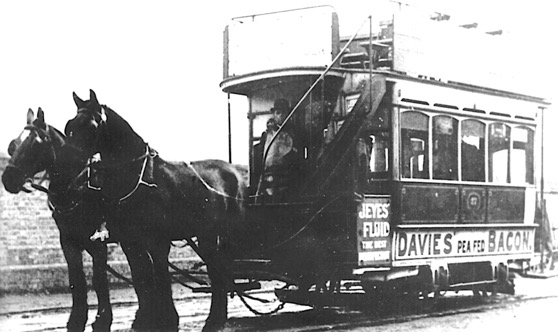
The driver of Horsecar No 27 poses for the camera at Selhurst Station — photo undated, but very probably taken in the last few months of operation (1901/2). The driver is wearing a full-length leather apron and a bowler hat. Photo courtesy of the Tramways and Light Railway Society, with thanks to David Voice.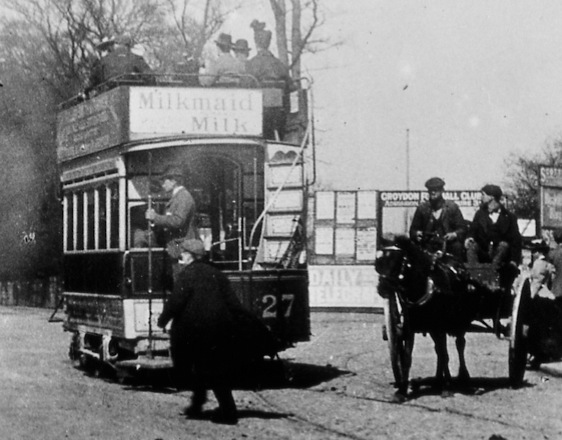
Another shot of Horsecar No 27 — photo undated, but probably taken shortly before the withdrawal of the last horsecar service (in January or February 1902) as No 27 is known to have been the last car running. The man on the rear platform is probably the conductor. Photo courtesy of the Tramways and Light Railway Society, with thanks to David Voice.
Motormen and conductors
A staff photograph, more than likely taken to commemorate the opening of the electric system in September 1901. All the uniformed staff are wearing the standard BETCo ‘Magnet & Wheel’ cap badge, above an employee number (for lower grades) or an embroidered 'Inspector' grade badge. There are a total of thirteen inspectors (seated on the second row); the front row comprises eight very youthful looking employees, very probably points boys. Author's Collection.
An enlargement of the above photograph showing a group of motormen and conductors. All present are wearing double-breasted, naval-style jackets with 'C C T' collar initials and tensioned-crown peaked caps with rain covers, the caps bearing the standard BETCo cap badge and an employee number.
Another enlargement of the above photograph, this time showing a few of the youths at the front, almost certainly points boys. Their uniforms are identical to those worn by motormen and conductors, save for the absence of an employee number.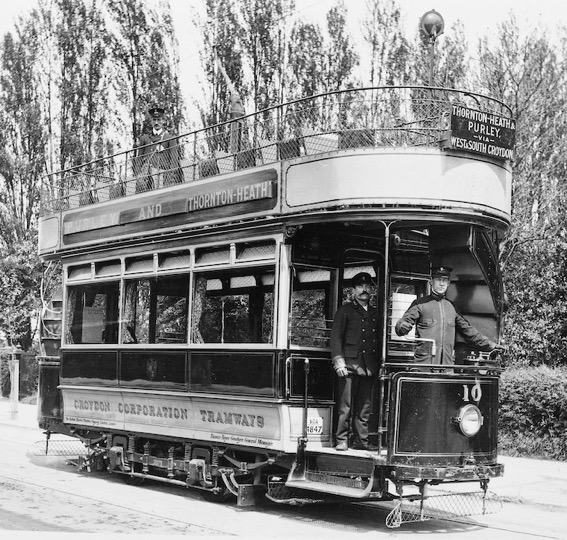
The crew of what would appear to be a fairly new Tramcar No 10 on a Purley and Thornton Heath service, with an inspector at the controls — photo undated, but probably taken in 1902/3 given that the lifeguard is a replacement for that originally fitted, and it also has new destination boxes. Photo courtesy of the National Tramway Museum. 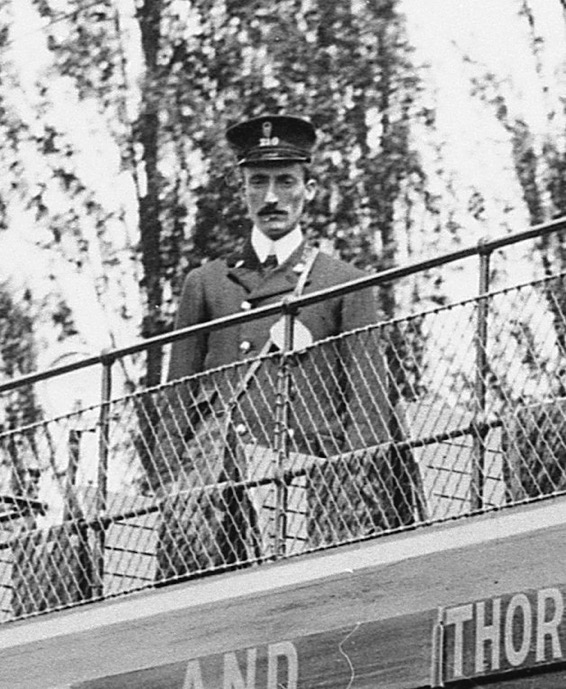
An enlargement of the above photograph showing the conductor — Employee No 210. His BETCo 'Magnet & Wheel' cap badge and 'C. C. T' collar initials are easily made out.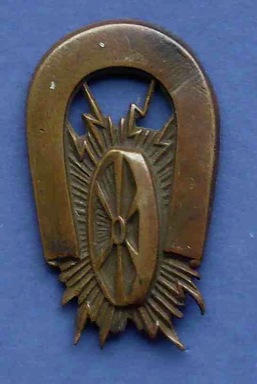
Standard British Electric Traction Company Limited ‘Magnet & Wheel’ cap badge — brass. Author's Collection.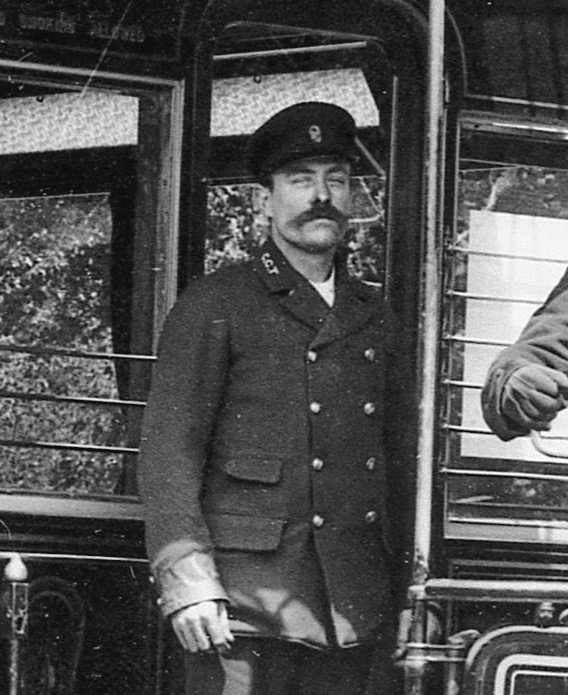
Another enlargement of the photograph above, this time showing the motorman.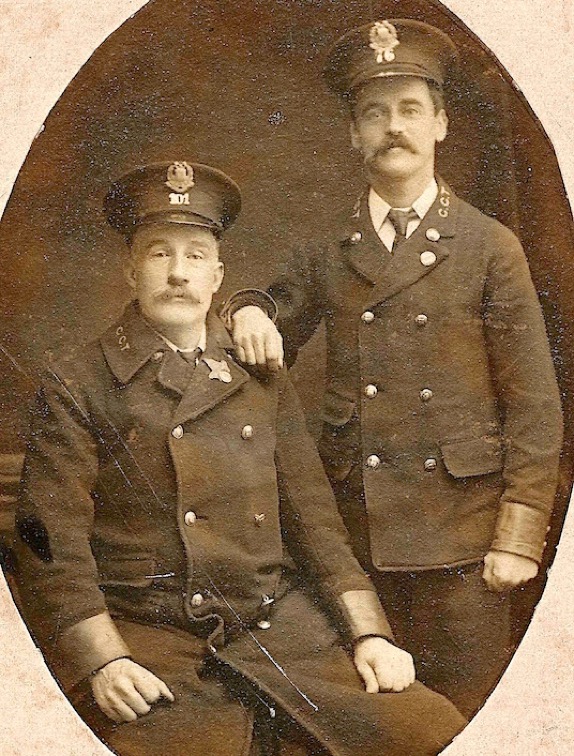
A studio portrait of two Croydon Corporation Tramways employees (Numbers 101 and 76) — photo undated, but definitely taken after the corporation take-over of 1906. Both men are wearing the standard municipal tramways cap badge (see below) and an employee number (worn beneath). The man on the right has a round badge of some description, worn on his left lapel, though its meaning is unclear. The significance of the maple leaf is also uncertain, but may be something to do with commemorating the Boer War, and in particular, the Canadian volunteers. With thanks to Richard Rosa.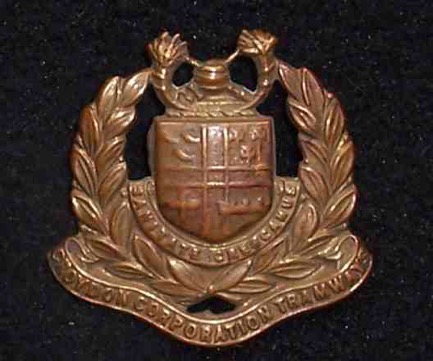
Croydon Corporation-era municipal tramways cap badge — brass. Author's Collection.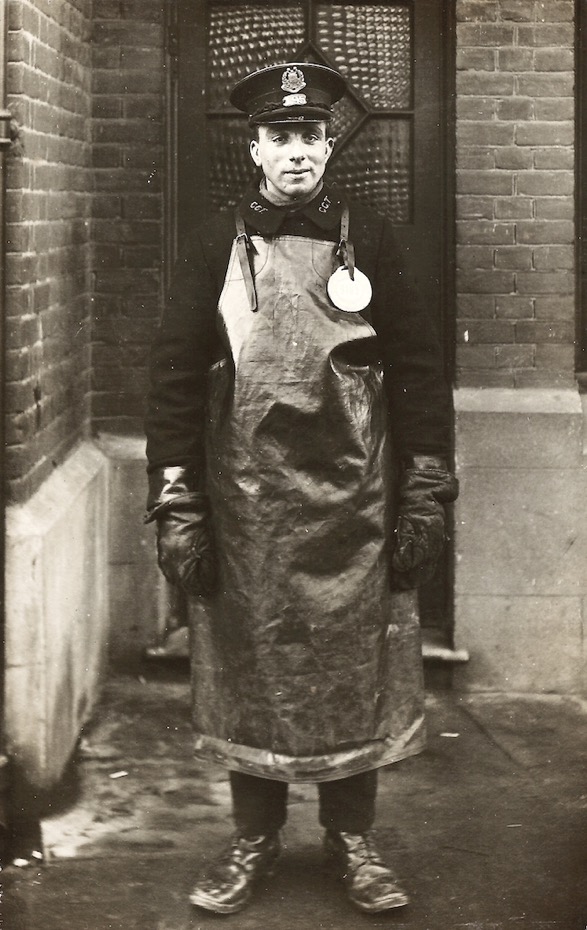
Corporation-era motorman (Employee No 195) wearing a long leather apron, and with a PCO badge (see link); the latter were always worn by tramcar crews when on duty. With thanks to Richard Rosa.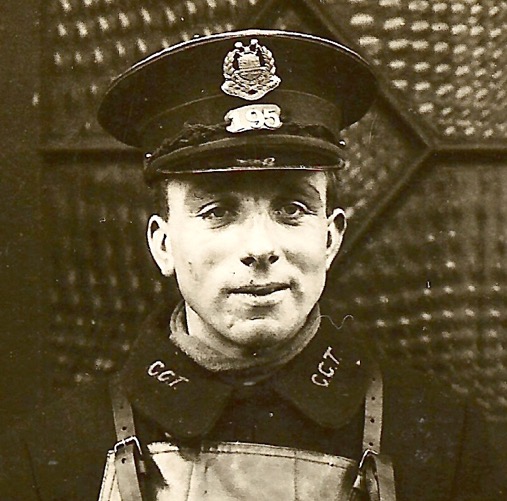
An enlargement of the above photograph showing the cap badge and what appears to be a home-made employee number. The embroidered greatcoat collar initials are also easily made out.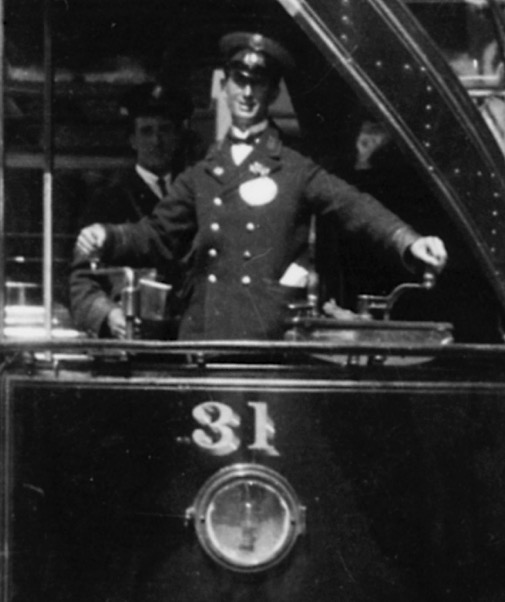
A motorman poses for the cameraman aboard Tramcar No 31 — date and location unknown, but possibly taken around 1910. By this time, the jackets had five pairs of buttons rather than the four used previously. Photo courtesy of the Tramways and Light Railway Society, with thanks to David Voice.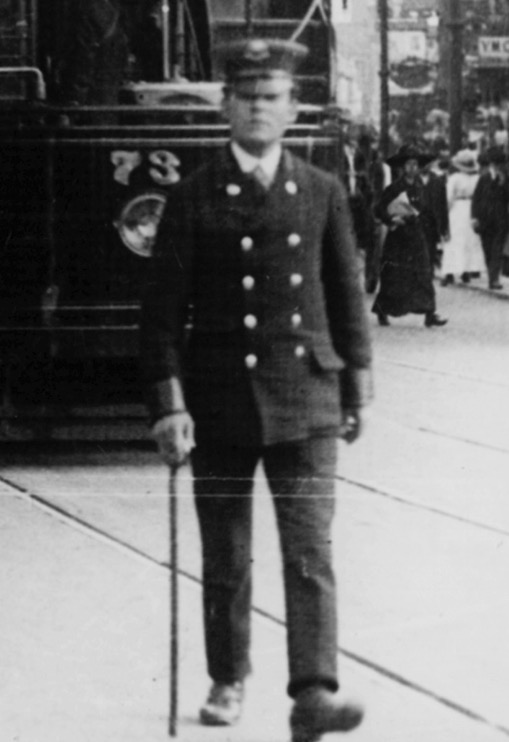
A points boy (with points iron) walks ahead of Tramcar No 73 — location and date unknown, but given the pristine condition of No 73, probably taken shortly after it was delivered in 1911. Photo courtesy of the Tramways and Light Railway Society, with thanks to David Voice.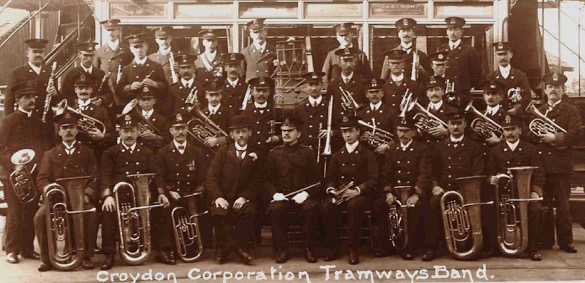
Croydon Corporation Tramways Band — photo taken after the corporation take over. Some of the staff are wearing employee numbers, whilst others are not. The bowler-hatted figure in the centre is the same dapper gentleman who appears with the Cricket Team in BETCo days (see below). With thanks to Richard Rosa.
Senior staff
Two of the inspectors from the 1901 staff photograph above. Their collars and hat bands both bear their grade — 'Inspector' — in embroidered script lettering.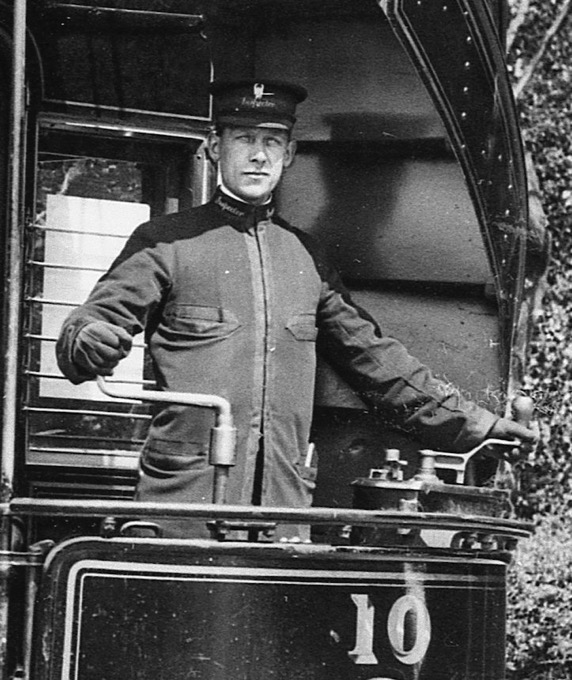
An enlargement of Tramcar No 10 photograph above, taken around 1902/3, and showing the inspector, who is at the controls.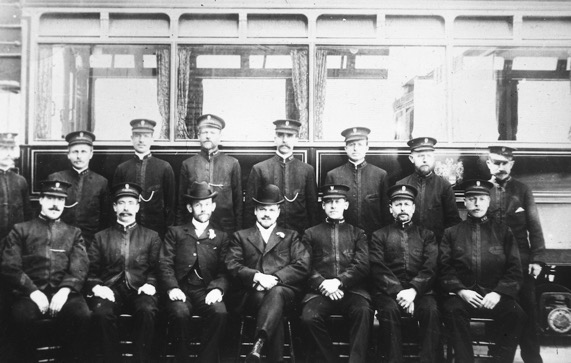
A group of thirteen CCT inspectors — photo undated, but certainly taken in BETCo days, i.e., no later than 1906. Photo courtesy of the National Tramway Museum. 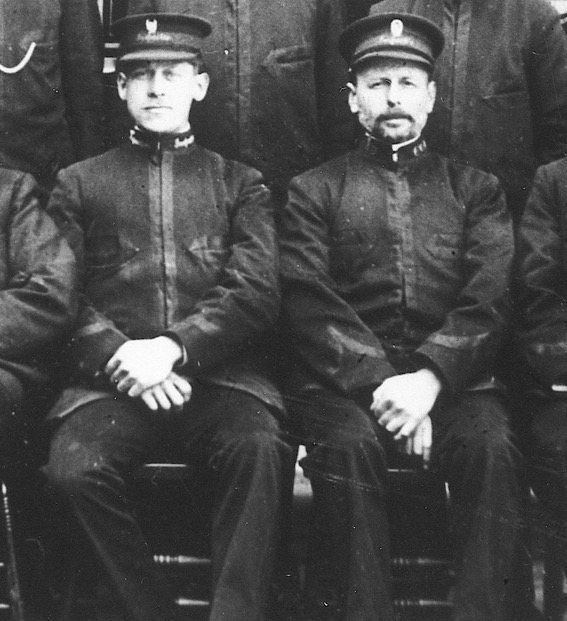
An enlargement of the above photograph showing two of the inspectors. Curiously, some of the men have 'Inspector' on both collars, some have Inspector on one collar and system initials on the other, and some system initials on both collars. The man on the left is almost certainly the same man who is seen at the controls of Tramcar No 10, above.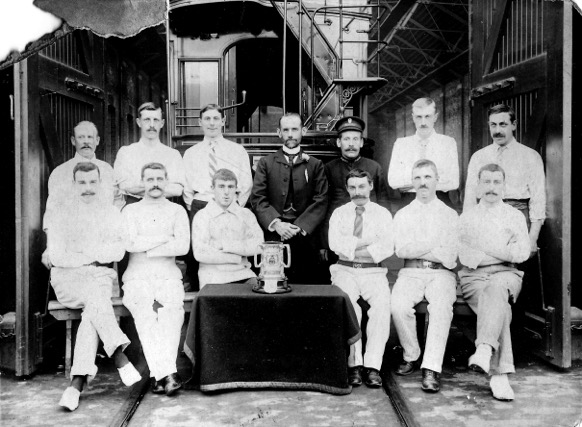
Croydon Corporation Tramways staff — most probably the cricket team — sometime between 1900 and 1906. The gentleman in the centre is very probably the General Manager, whilst the sole uniformed member of staff is an inspector. With thanks to Richard Rosa.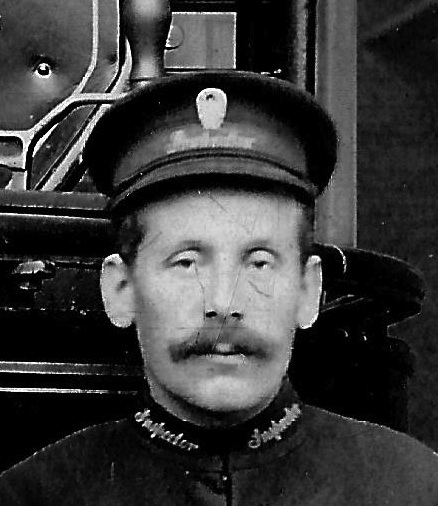
An enlargement of the above photograph showing the inspector's BETCo cap badge and embroidered 'Inspector' grade badges (beneath the cap badge and on the stand-up collars).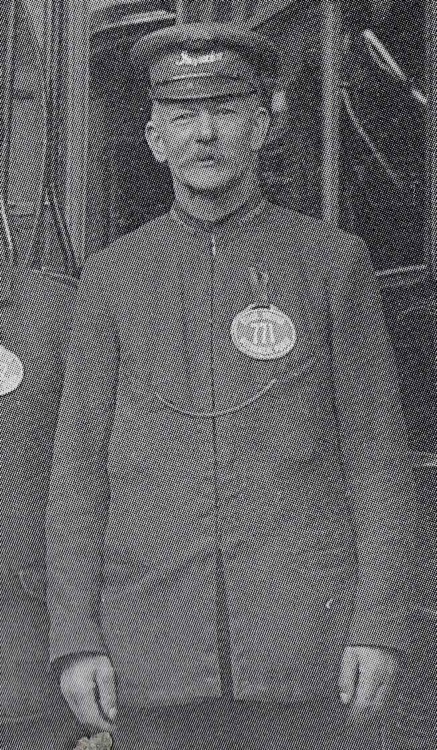
An enlargement of the Great War staff photo shown below. The subject is wearing the same style of inspector's jacket that was worn in BETCo days. Whilst the cap bears the subject's grade — 'Inspector' — the accompanying standard municipal tramways badge is difficulty to make out.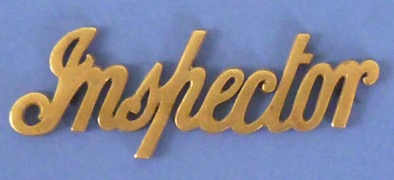
Croydon Corporation Tramways 'Inspector' cap badge; these were worn from 1906 to 1933— brass. Author's Collection.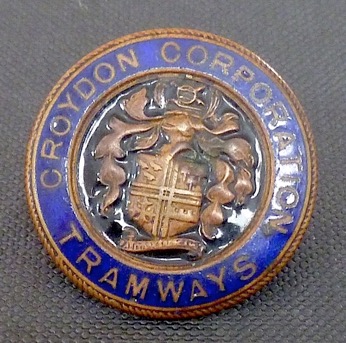
Possible later 'corporation-era' inspector's cap or lapel badge — gilt and blue enamel. Author's Collection.
Female staff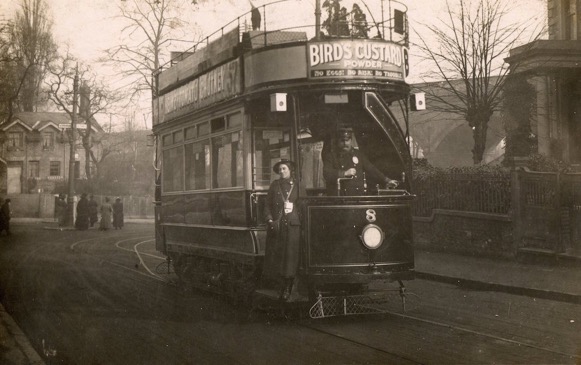
A Great War conductress and a motorman with Tramcar No 8 at Penge. Author's Collection.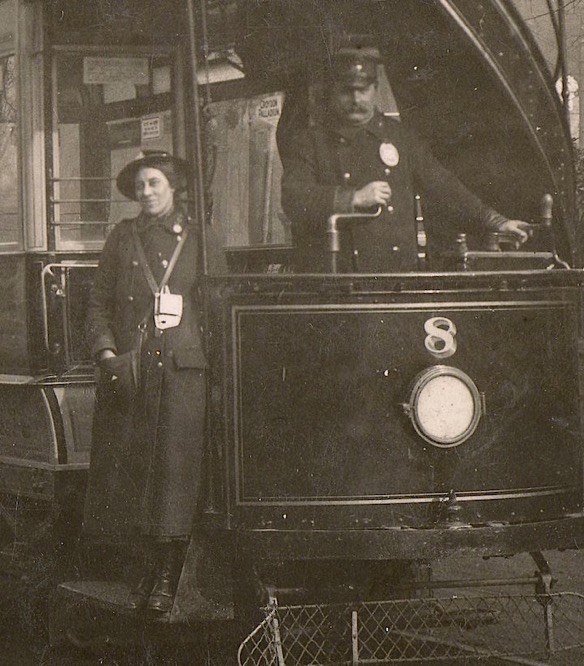
An enlargement of the above photograph showing the conductress and motorman.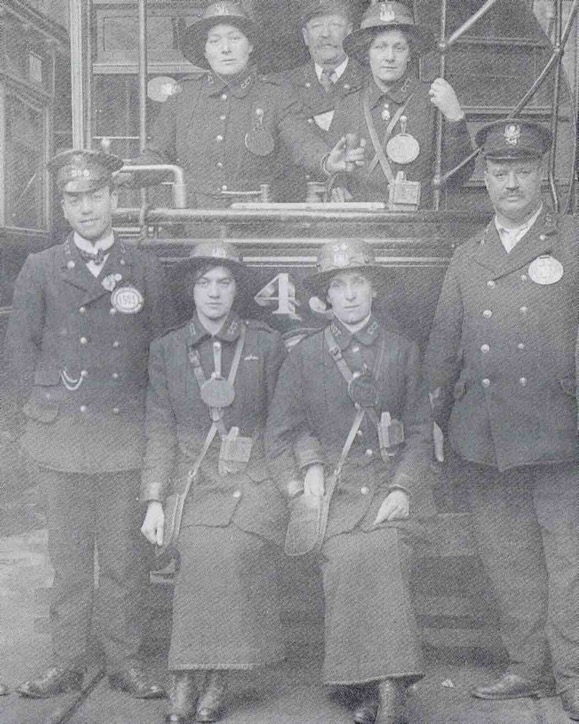
A staff photo taken during the Great War, which includes three conductresses and a motorwoman, though it is not clear whether women ever drove the trams; there were plans, but these were dropped due to opposition. All four of the ladies are wearing straw bonnets bearing the standard cap badge and an employee number above. J B Gent Collection, with kind permission of Robert Harley.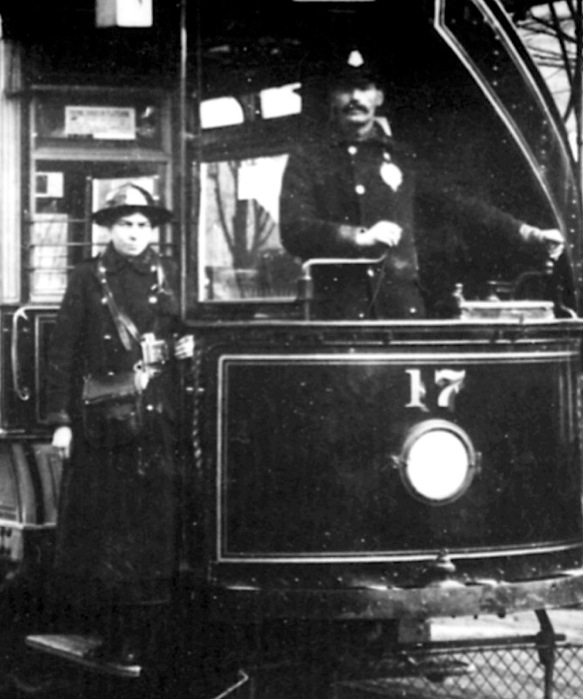
Another Great War photo taken at Penge, this time of Tramcar No 17. The conductress is wearing a waterproof bonnet. Photo courtesy of the Tramways and Light Railway Society, with thanks to David Voice.